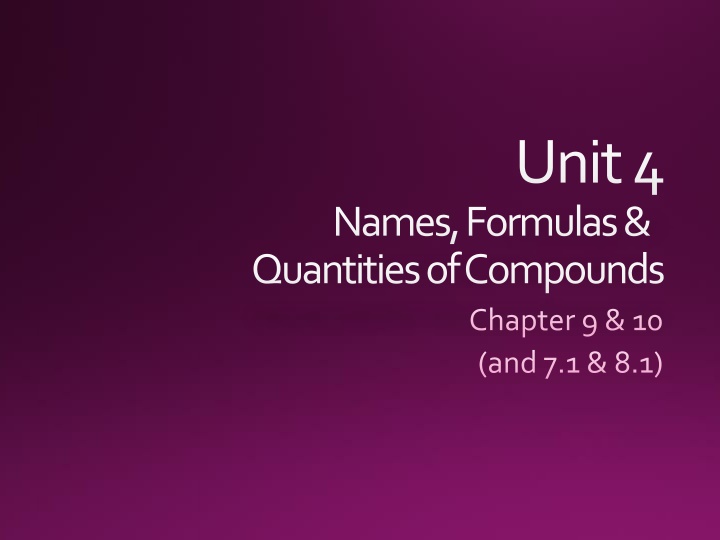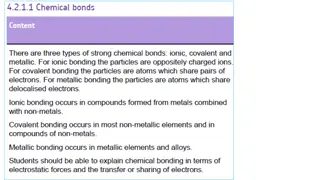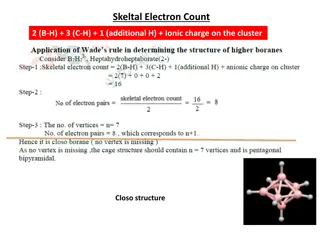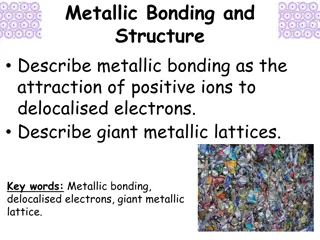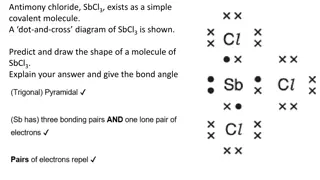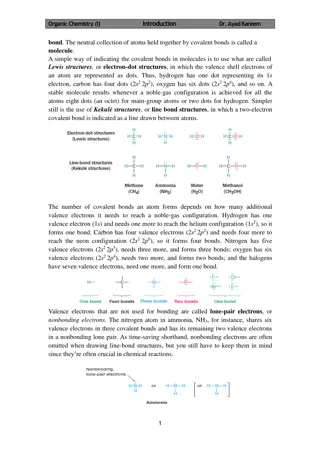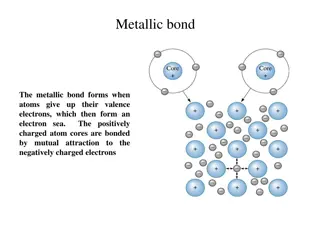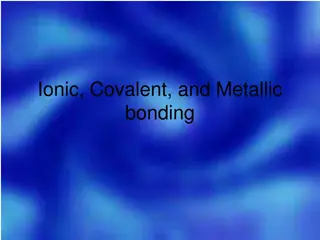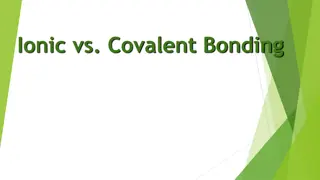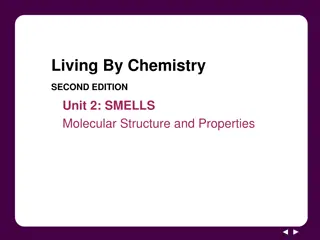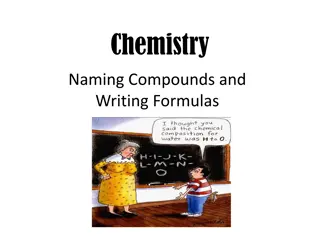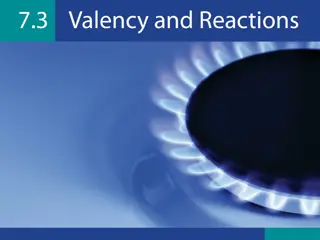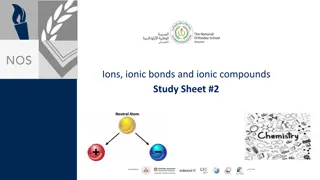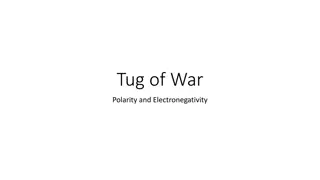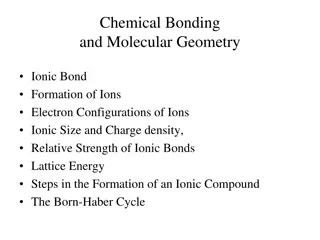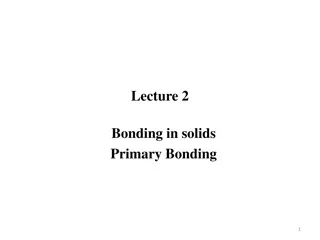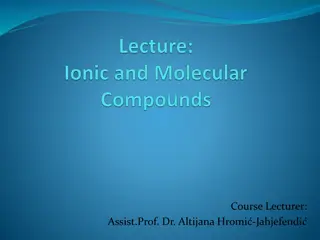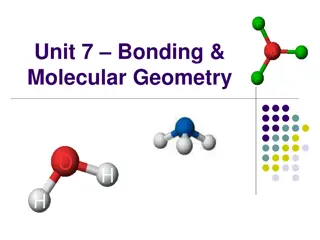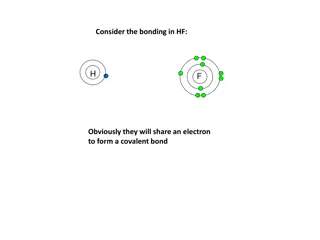Chemical Bonding and Compound Formulas: Understanding Ionic vs. Covalent Bonds
Explore the differences between ionic and covalent bonds, learn about ionic compounds held by electromagnetic attractions, understand molecular compounds with shared electrons, and grasp the naming conventions for ions. Discover how molecular formulas and formula units represent atoms in compounds.
Download Presentation

Please find below an Image/Link to download the presentation.
The content on the website is provided AS IS for your information and personal use only. It may not be sold, licensed, or shared on other websites without obtaining consent from the author.If you encounter any issues during the download, it is possible that the publisher has removed the file from their server.
You are allowed to download the files provided on this website for personal or commercial use, subject to the condition that they are used lawfully. All files are the property of their respective owners.
The content on the website is provided AS IS for your information and personal use only. It may not be sold, licensed, or shared on other websites without obtaining consent from the author.
E N D
Presentation Transcript
Unit 4 Names, Formulas & Quantities of Compounds Chapter 9 & 10 (and 7.1 & 8.1)
Warm-up 11/28 What is the difference between an IONIC bond and a COVALENT bond?
Ionic Compounds & Bonds ionic compound: Compound held together by ionic bonds. cations(+) attracting anions (-) Usually metal attracted to non-metal. Not a molecule, instead a matrix of ions attracted to each other in multiple directions. ionic bond: Electromagnetic attraction between + and ions. Cations attracting anions due to charge.
Molecular Compounds & Bonds covalent bond: A sharing of electrons Usually occurs between 2 or more non-metals. molecule: A group of atoms joined together by covalent bonds. 2 types: molecular compounds: 2 or more elements covalently bonded. Example: Water H2O diatomic molecule: Element in molecule form. Examples: Oxygen Hydrogen Nitrogen Halogens O2 H2 N2
Ionic vs. Molecular Compounds MOLECULAR lower melting points Often liquids or gases Molecules Non-metals together Electrons shared. Covalent bonds IONIC High melting points Crystal solids Formula unit Metal cation + non-metal anion Electrons given and taken. Ionic bonds Introduction Video
Chemical Formulas molecular formula: Actual # of atoms found in molecule. molecular compound non-metal only Molecular formulas are molecule units. formula unit: Lowest whole number ratio of balanced ions. ionic compound metal and non-metal (important exception NH4+) Ionic are repeating patterns of ions.
Monoatomic Ions monoatomic ions: Consist of a single ion with a positive or negative charge. 1.) representative elements (non transition metals): Know the charges! Cations: Name is the name of the element. Ex: Ca2+ = Calcium ion Anions: Name ending changed to end in ide . Ex: O2- = Oxide 2.) transition metals: Can have multiple charges! Cations: Name must give charge (Use Roman Numeral) Ex: Cu2+ = Copper (II) Cu1+ = Copper (I)
Sample Problem 9.1 Name the ion formed by each of the following elements: potassium lead, 4 electrons lost c. sulfur
Example Problems 1. Name the ions formed by the following elements: a. selenium c. phosphorus b. barium d. iodine How many electrons were lost or gained? a. Iron (III) b. Oxide c. Copper (I) d. Strontium ion
Polyatomic Ions Composed of more than one atom Molecules with charge Need to memorize or have access to list. Page 268 Items to Know Sheet for Naming
9.2 Naming and Writing Formulas for Ionic Compounds
Binary Ionic Compounds Ionic Compounds of two elements Metal Cation + Non-Metal Anion To name: Place the cation name first followed by the anion name. Formula must be balanced with charges.
Example: Ionic Compound Do the following compounds exist? LiO? Li2O? LiO2? Li2O2?
Example: Ionic Compound Do the following compounds exist? LiO? Li2O? Only formula that exists LiO2? Li2O2? That is why we don t need mono , di , or tri in ionic compound names!
Ionic Compound Naming Rules The cation is always named first! 1.) Name the cation (usually the metal ion) using the same name as the element. If the cation is a transition metal, use a Roman numeral following the element name to indicate the charge, but only for cations that form multiple ions! 2.) Name the anion If a single element, replace the last syllable with ide . If a polyatomic ion, just use its name.
Name the following compounds: LiBr CaO Sr(NO2)2 Rb2SO4 Fe2O3 CaCr2O7 Na2CO3
Name the following compounds: LiBr Lithium bromide CaO Calcium oxide Sr(NO2)2 Strontium nitrite Rb2SO4 Rubidium sulfate Fe2O3 Iron III oxide *** hardest one! CaCr2O7 Calcium dichromate Na2CO3 Sodium carbonate
Formula Unit Rules The formula must be balanced with lowest whole # ratio of ions. The number of each ion depends on its charge and the charge of the other ion. Try crossing the charges.
Write the formula for the following compounds: Sodium oxide + 1 O : Na Copper (I) sulfide + 1 Cu Na2 O 2 2 : S Cu2 S Barium oxide Copper (II) sulfate BaO 2 + + 2 CuSO 2 2 Cu : SO Ba : O 4 4 Aluminum oxide O : Al Ammonium phosphate + 1 4 PO : NH 3 + 3 2 (NH ) PO Al 2O 4 4 3 4 3 Calcium chloride Iron (III) nitrate + 2 1 CaCl Ca : Cl 1 2 + 3 Fe(NO 3) Fe : NO 3 3
9.3 Naming and Writing Formulas for Molecular Compounds
Binary Molecular Compounds Write the names of the elements in the order listed in the formula. Use prefixes to indicate the number of each kind of atom. Exception: If the first element is 1 don t use mono. End the name of the second element with the suffix ide .
Prefix Table 9.4 page 281 Prefix mono di tri tetra penta hexa hepta octa nona deca Number 1 2 3 4 5 6 7 8 9 10
Name the following compounds: CO CO2 N2O4 PCl5 XeF6 CCl4
Name the following compounds: CO Carbon monoxide CO2 Carbon dioxide N2O4 Dinitrogen tetraoxide PCl5 Phosphorus pentachloride XeF6 Xenon hexafluoride CCl4 Carbon tetrachloride
Molecular Formula Review Represents the ACTUAL number of atoms in the MOLECULE. Name is a list of the elements present.
10.1 The Mole. A unit of measurement
What is a mole? A mole is similar to the concept of a dozen. Why do you count cookies in dozens? Because it is more convenient. Why do you count chemistry particles in moles? Because it is more convenient. A mole is a number of particles. 1 mole (mol) = 6.02 x 1023particles (Avogadro s Number)
How big is Avogadro's number? An Avogadro's number of soft drink cans would cover the surface of the earth to a depth of over 200 miles. If you spread Avogadro's number of unpopped popcorn kernels across the USA, the entire country would be covered in popcorn to a depth of over 9 miles. If we were able to count atoms at the rate of 10 million per second, it would take about 2 billion years to count the atoms in one mole.
If you count out loud starting with the number "one" at the rate of one count every second, it may take you about 1,909,577,942,668,696 years to finish. This is roughly 960,000 times the estimated lifetime of our universe (assuming 20 Billion years). Using a Pentium 450 MHz CPU, it will still take about 4,243,506 years to finish this task. This is a period of time about a thousand times longer than the total span of our civilization. If marbles that have a diameter of one centimeter were to be lined up end-to-end in a straight line, the distance covered by this string of marbles can hold in about 500,000,000 of our Solar System placed end-to-end.
What is a particle? It depends on the substance and situation. Atoms, Molecules, Formula Units are all particles. Element: Atom Diatomic Element: Molecule Molecular Compound: Molecule Ionic Compound: Formula Unit REPRESENTATIVE PARTICLES: ATOMS, MOLECULES, or FORMULA UNITS
aluminum All are particles!
Mole Conversions 1 ???? # ????????? = __________________ 6.02 ? 1023????????? 6.02 ? 1023????????? 1 ???? # ????? = __________________ Example Problems 1) 3.2x1024molecules of water is how many moles of water molecules? 2) 1.50 mol of Carbon dioxide is how many molecules? 3) 0.10 mol of NaCl is how many formula units?
Sample Problem 10.2 Magnesium is a light metal used in the manufacture of aircraft, automobile wheels, and tools. How many moles of magnesium is 1.25 x 1025atoms of magnesium?
Sample Problem 10.3 Propane is a gas used for cooking and heating. How many atoms are in 2.12 mol of propane (C3H8)?
Molar Mass Why is a mole = 6.02 x 1023? Mole: 6.02 x 1023 particles This number unites a number of particles and the atomic mass of substances. 1 mole of a substance has a mass equal to its atomic mass in grams. Molar Mass = mass of 1 mole of a substance Molar Mass = (atomic mass) g s
Mole Examples # of Atoms or Ions Mass of 1 Particle Mass of 1 Mole Representative Particle Substance NaCl Copper Water Hydrogen gas
Mole Examples # of Atoms or Ions Mass of 1 Particle Mass of 1 Mole Representative Particle Substance 22.99 + 35.45 58.44 amu s NaCl Formula Unit 2 58.44 g Copper Water Hydrogen gas
Mole Examples # of Atoms or Ions Mass of 1 Particle Mass of 1 Mole Representative Particle Substance 22.99 + 35.45 58.44 amu s NaCl Formula Unit 2 58.44 g Copper Atom 1 63.55 amu s 63.55 g Water Hydrogen gas
Mole Examples # of Atoms or Ions Mass of 1 Particle Mass of 1 Mole Representative Particle Substance 22.99 + 35.45 58.44 amu s NaCl Formula Unit 2 58.44 g Copper Atom 1 63.55 amu s 63.55 g 2 1.01 + 16.00 18.02 amu s Molecule H2O Water 3 18.02 g Hydrogen gas
Mole Examples # of Atoms or Ions Mass of 1 Particle Mass of 1 Mole Representative Particle Substance 22.99 + 35.45 58.44 amu s NaCl Formula Unit 2 58.44 g Copper Atom 1 63.55 amu s 63.55 g 2 1.01 + 16.00 18.02 amu s Molecule H2O Water 3 18.02 g Hydrogen gas Molecule H2 1.01 + 1.01 2.02 amu s 2 2.02 g
Sample Problem 10.4 The decomposition of hydrogen peroxide (H2O2) provides sufficient energy to launch a rocket. What is the molar mass of hydrogen peroxide?
Additional Examples: What are the molar masses of the following compounds? Ag2SO4 Mg(NO3)2 C6H12O6
10.2 Mole Mass Relationship 1 ???? ???? ?? ????? = ______________________ ????? ???? ?? ????? ????? ???? ?? ????? 1 ???? # ????? = __________________________ Example Problems 1) 23.8 g of water contains how many moles of water molecules? 2) 1.50 mol of Carbon dioxide has what mass? 3) 0.10 mol of NaCl has what mass?
Sample Problem 10.5 What is the mass, in grams, of 9.45 mol of aluminum oxide?
Sample Problem 10.6 How many moles of iron(III) oxide are contained in 92.2 g of pure Fe2O3?
Mole Volume Relationship For gasses, a mole is also related to volume. At a common temperature and pressure (STP): 1 mole = 22.4 L STP = Standard Temperature and Pressure STP is 0 C and 1 atm of pressure (sea level on earth)
Volume to Mole Conversions At STP 1 ???? 22.4 ? ?????? ?? ?????? = ____________________ 22.4 ? 1 ???? # ????? = _______________________ Example Problems 1) 34.6 L of Oxygen at STP is how many moles of Oxygen? 2) 1.50 mol of Carbon dioxide is what volume at STP? 3) 0.10 mol of N2is what volume at STP?
